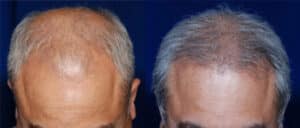Patterned baldness and overall thinning hair are expected in 60% of men and 50% of women worldwide. People will often decide to take action when 50% of their hair has already fallen out before researching surgical options. The truth is, there is no need to wait. If you’re feeling self-conscious about moderate to extreme hair loss, it’s time to take action and find the best method while considering effectiveness, cost, and how long results will last.
If you’re feeling less confident because of balding and want a minimally invasive, affordable, and permanent option, an FUE Hair Transplant (Follicular Unit Extractions) is the way to go.
What is an FUE Hair Transplant Surgery
An FUE Hair transplant is a minimally invasive surgery in which individual hair follicles are pulled from one part of your body, and transferred to balding areas.
- FUE is done in mini sessions: 2-4 hour sessions within multiple days. Or a mega session: up to a 10-hour day
- Your trusted surgeon will gently shave the appropriate areas on your head
- A numbing agent will be applied
- Healthy hair follicles are extracted using a special tool called a micropunch
- Using a blade, the surgeon applies a series of small incisions throughout the scalp
- The hair will be planted in the tiny incision openings, allowing them to begin growing new, healthy hairs
- Your surgeon will clean and bandage the area for a safe recovery
Are FUE transplants painful?
Most patients report feeling little to no pain throughout the process because the procedure is minimally invasive. All that is needed is a numbing agent to ease any discomfort; there are no stitches, staples, or large cuts made. The recovery may have some mild tenderness, but this lasts no more than a week. FUE is considered to be pain-free compared to other hair restoration techniques.
Are FUE Hair Transplants successful?
The FUE Hair Transplant is a safe treatment. that’s minimally invasive and has a success rate of 95% – 100%.
- No linear scarring
- Advanced technology for minimal discomfort
- Fast recovery
- Affordability
- Permanent results
How long does an FUE Hair Transplant last?
FUE Hair Transplants provide permanent results. Results may vary – but the FUE has a fantastic reputation. Results are also dependent on your trusted surgeon – with the right experienced physician, your hair restoration will have lifelong results that show.
How FUE Transplants work
An FUE works by the donor follicles holding their characteristics, which leads to growth. In addition, the hair used to help areas regrow is usually DHT-resistant.
DHT is a powerful hormone that communicates to receptors to shrink hair follicles, leading to a shorter hair growth phase and, eventually, overall hair thinning.
When you think of patterned balding, can you picture a bare center, full back and sides of the head? That’s because the thicker areas with hair are DHT-resistant. So the more vital, fuller, healthier hair is used on the thinning areas during an FUE transplant surgery.
Hair transplant options
Two common hair transplant options are the FUE (Follicular Unit Extractions) and the FUT (Follicular Unit Transplantation).
FUE involves taking individual hair follicles from donor sites where hair is not shedding. This procedure uses micrografting technology (1-4 hair follicles transplanted at a time) to the recipient area of the head. Because it is such a strategic procedure focusing on small areas at a time, there is no scarring.
The Follicular Unit Transplantation (FUT) procedure is as follows:
- A scalpel takes a large patch of skin (6-10 inches) with hair
- The area is then closed with staples or stitches
- The surgeon splits the piece of skin into smaller pieces, called grafts
- A needle makes holes in the scalp where the hair from the grafts is transplanted (grafting)
- A bandage covers the area for safe healing
What is Better: FUE or FUT?
Though it is best to be evaluated by your medical provider to ensure the safest route for your desired outcome – when weighing out the options, FUE tends to be best.
The FUT transplant surgery can give the “hair plug” look and also results in a linear scar on the scalp where the strip of hair was removed. Whereas no surgical stitches are needed for the FUE. Some patients also complain of experiencing headaches post FUT procedure due to the tightened scalp.
Where does hair for a transplant come from?
Donor sites are used for hair transplants. These areas are where thinning is less likely to occur:
- the nape of the neck
- back of the head
- above the ears
Will hair transplant donor sites grow back?
The hair harvested from the donor sites will grow back. Thinning and balding tend to happen in patterns. Transferring hair from one part of your body to another is completely safe.
FUE Recovery
There is minimal downtime or pain during the recovery of an FUE hair graft procedure:
- Avoid washing for at least three days.
- When you begin to wash, your scalp may be tender and sensitive. Make sure your shampoo of choice is mild, unscented, and gentle.
- Wait to wear hats or covers on your head until you receive the OK from your hair transplant surgeon.
- Skip the gym and strenuous exercise for a week.
The healing process is different for everyone, but a common factor may be some hair fallout (this is completely normal as the hair grafts settle). You might also experience some swelling post-procedure, but here are some ways to alleviate it:
- Ibuprofen or Advil
- You may be prescribed antibiotics to avoid infection
- Anti-inflammatories from an oral steroid
How Long Will it Take to See FUE Results?
Your FUE transplant areas will begin to grow and can be seen in as little as 3-4 months. Most see dramatic growth around 4-6 months. This is a process that involves patience, but the long – lasting, permanent results, will be well worth it. Within a year, you will have your final results that look, feel, and move just like the rest of your hair.
Can FUE Hair Transplant be done on other body parts?
While the scalp is the most common for Follicular Unit Extraction, it can be performed anywhere on your body that is experiencing thinning:
- Beard
- Arms
- Legs
- Eyebrows
To know whether or not an area is a candidate for FUE, you will need to ask your surgeon to ensure it is safe.
What to do Before Hair Transplant Surgery
You will have a conversation with your provider to discuss what to do and not to do during the days leading up to your surgery. Here are some examples of what to expect.
- Discuss medications you’re currently taking (prescribed, over the counter, beta blockers, and blood thinners)
- Avoid Vitamins B + E, as well as Aspirin and NSAIDS one week before surgery
- Avoid alcohol at least 3 days prior
- Avoid caffeine the day of
- Wash your hair the morning of and avoid any styling products
- Dress comfortably – you will be awake during the transplant
How Much Does Hair Restoration Cost?
Because FUE Hair Transplants are considered cosmetic procedures, most insurance companies won’t cover the cost of the surgery. However, the starting cost for most surgical facilities is around $4000, and payment plans are typically accepted.
As a permanent option, an FUE Hair Transplant cost depends on a few factors:
- Residential location
- The base cost your surgeon requires
- Experience of the surgeon
- Progression of hair loss
- The size of the transplant area
Because FUE Hair Transplants are considered cosmetic procedures, most insurance companies won’t cover the cost of the surgery. However, the starting cost for most surgical facilities is around $4000, and payment plans are typically accepted.
This is compared to other oral or topical hair restoration options. No pill, cream, or spray can 100% restore your hair because sometimes they don’t work.
At least 12.68 million people reported purchasing hair regrowth products in 2022.
- Topical products like Minoxidil (Rogaine) must be used indefinitely to experience and maintain results. People can spend up to $420 annually.
- Oral Supplements can help support blood flow and feed your body nutrients to sustain healthy hair. But these are also recommended to be taken indefinitely. People pay upwards of $1,065 annually for pill subscriptions or vitamins.
Is FUE for you?
When determining whether or not the FUE route is for you, we recommend starting with an FUE Hair consultation! It is important to have a meeting where you will be screened to ensure FUE is for you. Here, your surgeon will evaluate your current hair loss, hair texture, your desired outcome, and whether you have a sufficient amount of donor hair for a successful procedure.
When weighing out hair restoration options, an FUE is well worth considering. A full head of hair doesn’t have to be a far-fetched idea. The recovery time is simple and won’t take you away from your normal, everyday life. And though seeing new hair growth takes time, the lasting results keep the popularity of the FUE Hair Transplant going.



